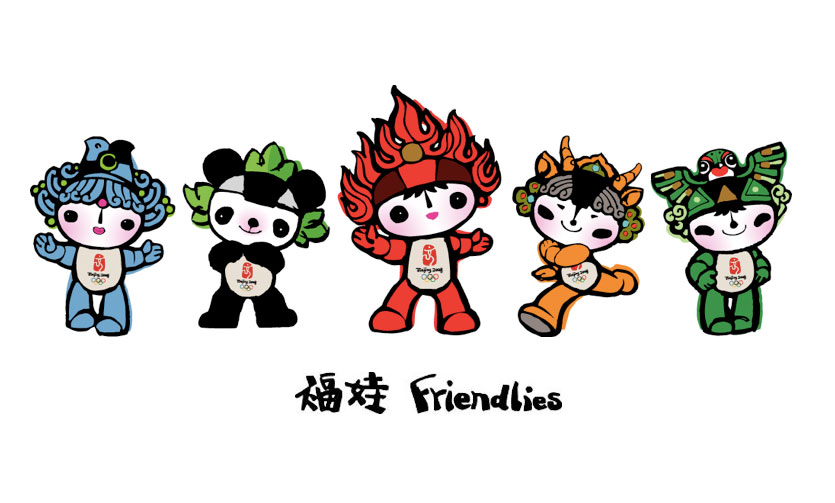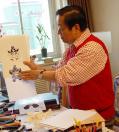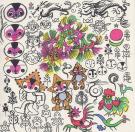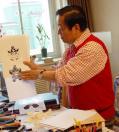

奥运福娃 FUWA for 2008 Beijing Summer Olympics
著名艺术大师韩美林被誉为“福娃之父”,是2008年北京奥运会吉祥物福娃的领衔设计者。长久以来,中国就有通过符号传递祝福的传统。北京奥运会吉祥物的每个福娃都代表着一个美好的祝愿:繁荣、欢乐、激情、健康与好运。五个福娃带着北京的盛情,将祝福带往世界各个角落,邀请各国人民共聚北京,欢庆2008奥运盛典。
可爱的福娃经历了一个曲折艰辛的诞生过程:数百个日日夜夜,4000多张手稿,60多次修改,仅构思所涉及的参考资料就足足装满了74个大纸箱。
福娃的色彩是奥运五环的“红、黄、蓝、黑、绿”,是五大洲的颜色,也是神州的山川大地、江河湖海的颜色,形象的灵感来自鱼娃、大熊猫、藏羚羊、京燕以及奥林匹克圣火,头饰的造型分别意指海洋、森林、圣火、大地和天空,暗含了“金、木、水、火、土”五行之意。整个设计充满了民族文化的元素,几乎是“无一笔无出处”,体现了中国传统文化、奥林匹克精神以及北京奥运会“人文奥运”的理念。五个“福娃”取“北京欢迎您”的谐音命名,传递了好客的北京对世界的热情,传递了中华民族对友谊、和平及人与自然和谐相处的美好愿望。
Fuwa is the mascots of 2008 Beijing Olympic Games, which was officially released on November 11, 2005 –1000 days left to the opening ceremony of Beijing Olympic Games.
Han Meilin is the “Father of Fuwa”. Lovely Fuwa has experienced an arduous process of birth--several hundred days and nights, over 4,000 pieces of manuscripts, more than 60 times revisions—only the references and drafts filled with 74 large boxes.
The color of Fuwa was derived from the Olympic Rings “Red, Yellow, Blue, Black and Green”, which are the colors of five continents and Chinese divine land. Beibei is the Fish, Jingjing is the Panda, Huanhuan is the Olympic Flame, Yingying is the Tibetan Antelope and Nini is the Swallow. Their head wears refer to the sea, forest, holy fire, earth and sky, which symbolize Five Elements in China “Wood, Fire, Water, Metal and Earth”. The designs of Fuwa are full of Chinese national cultural elements, which express Chinese traditional culture, Olympic spirit and the People’s Olympics Idea of Beijing Olympic Games. Five Fuwa exceed the number of all previous Olympic Games’ Mascots. Each fuwa represents a beautiful wish: prosperity, happiness, passion, health and good luck. Each Fuwa has a rhyming two-syllable-name—a traditional way of expressing affection for children in China. When you put their names together- Bei Jing Huan Ying Ni – meaning “Welcome to Beijing”.
可爱的福娃经历了一个曲折艰辛的诞生过程:数百个日日夜夜,4000多张手稿,60多次修改,仅构思所涉及的参考资料就足足装满了74个大纸箱。
福娃的色彩是奥运五环的“红、黄、蓝、黑、绿”,是五大洲的颜色,也是神州的山川大地、江河湖海的颜色,形象的灵感来自鱼娃、大熊猫、藏羚羊、京燕以及奥林匹克圣火,头饰的造型分别意指海洋、森林、圣火、大地和天空,暗含了“金、木、水、火、土”五行之意。整个设计充满了民族文化的元素,几乎是“无一笔无出处”,体现了中国传统文化、奥林匹克精神以及北京奥运会“人文奥运”的理念。五个“福娃”取“北京欢迎您”的谐音命名,传递了好客的北京对世界的热情,传递了中华民族对友谊、和平及人与自然和谐相处的美好愿望。
Fuwa is the mascots of 2008 Beijing Olympic Games, which was officially released on November 11, 2005 –1000 days left to the opening ceremony of Beijing Olympic Games.
Han Meilin is the “Father of Fuwa”. Lovely Fuwa has experienced an arduous process of birth--several hundred days and nights, over 4,000 pieces of manuscripts, more than 60 times revisions—only the references and drafts filled with 74 large boxes.
The color of Fuwa was derived from the Olympic Rings “Red, Yellow, Blue, Black and Green”, which are the colors of five continents and Chinese divine land. Beibei is the Fish, Jingjing is the Panda, Huanhuan is the Olympic Flame, Yingying is the Tibetan Antelope and Nini is the Swallow. Their head wears refer to the sea, forest, holy fire, earth and sky, which symbolize Five Elements in China “Wood, Fire, Water, Metal and Earth”. The designs of Fuwa are full of Chinese national cultural elements, which express Chinese traditional culture, Olympic spirit and the People’s Olympics Idea of Beijing Olympic Games. Five Fuwa exceed the number of all previous Olympic Games’ Mascots. Each fuwa represents a beautiful wish: prosperity, happiness, passion, health and good luck. Each Fuwa has a rhyming two-syllable-name—a traditional way of expressing affection for children in China. When you put their names together- Bei Jing Huan Ying Ni – meaning “Welcome to Beijing”.


























